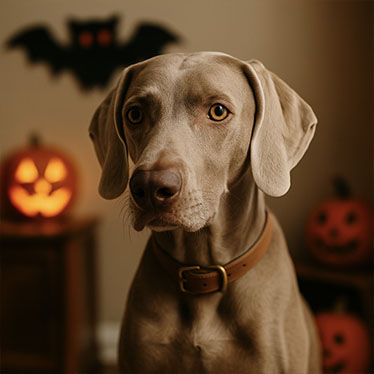
Halloween can be a fun time for families, but for pets, it can be a real fright-fest. With the doorbell constantly ringing, strangers in costumes, loud noises, and unfamiliar smells, it’s no surprise many pets experience stress during this spooky season. Thankfully, with some preparation and awareness, you can help ease pet anxiety on Halloween and ensure a safe, calm evening for your furry companions.
🎃 Why Halloween Triggers Pet Anxiety
Halloween introduces a slew of stressors for pets, including:
- Repeated doorbell rings and knocking
- Strange costumes and masks that conceal familiar human scents
- Loud, unfamiliar sounds like fireworks or loud music
- Excited children or trick-or-treaters moving quickly or unpredictably
- Tempting but toxic treats like chocolate or candy
For pets that already have anxiety or are fearful of strangers or loud noises, this night can be especially overwhelming.
🧸 Create a Safe, Quiet Space
One of the best ways to reduce pet anxiety on Halloween is to create a retreat for your dog or cat. Choose a quiet room away from the front door and activity, and make it cozy with:
- Their bed or crate
- Calming music or white noise
- Their favorite toys or comfort objects
You can even diffuse pet-safe calming sprays like Adaptil (for dogs) or Feliway (for cats), which release pheromones known to soothe anxious pets.
🍬 Avoid the Doorbell Chaos
If your pet reacts to the doorbell, consider these alternatives:
- Sit outside to greet trick-or-treaters so the bell doesn’t ring
- Put up a sign asking guests not to knock
- Keep pets in their safe room with the door closed, or use a baby gate to block their access to the front door
Additionally, providing a treat-filled toy like a Kong or puzzle feeder can distract and comfort them during peak trick-or-treating hours.
👻 Costume Considerations
Costumes can be cute, but they’re not for every pet. If your pet shows signs of discomfort—such as flattening their ears, freezing in place, or trying to remove the costume—it’s best to skip it or opt for a simple Halloween bandana instead.
If your pet does tolerate costumes, ensure:
- It fits properly and doesn’t restrict movement
- There are no small, chewable parts
- They are supervised while wearing it
Learn more costume safety tips in our post: DIY Halloween Costumes for Pets.
🔒 Keep Candy Out of Reach
Chocolate, xylitol (found in sugar-free gum), raisins, and certain nuts are all toxic to pets. Remind guests and kids to keep treats out of paw’s reach, and have a pet-friendly treat on hand so your furry friend doesn’t feel left out.
If you suspect your pet has eaten something toxic, contact your vet immediately or call the ASPCA Animal Poison Control at (888) 426-4435.
💊 Consider Supplements or Calming Aids
For pets with moderate to severe anxiety, natural calming chews or even prescription medications may help. Speak with your veterinarian before Halloween to discuss safe options for your pet.
Popular options include:
- CBD treats made for pets
- L-theanine and melatonin supplements
- Vet-approved anti-anxiety medications
🐾 Stick to Routine as Much as Possible
Feeding and walking your dog or playing with your cat at their usual times can help provide a sense of normalcy. Pets thrive on routine, and keeping that stable can help balance out the stress of a chaotic evening.
Disclaimer: This blog is for informational purposes only. Always consult your veterinarian before introducing new supplements or medications to your pet’s routine.
References:
- American Kennel Club. “Halloween Safety Tips for Dogs.”
https://www.akc.org/expert-advice/health/halloween-safety-tips-for-dogs/ - ASPCA. “Halloween Safety Tips.”
https://www.aspca.org/pet-care/general-pet-care/halloween-safety-tips - VCA Hospitals. “Halloween Safety and Your Pet.”
https://vcahospitals.com/know-your-pet/halloween-safety-and-your-pet


